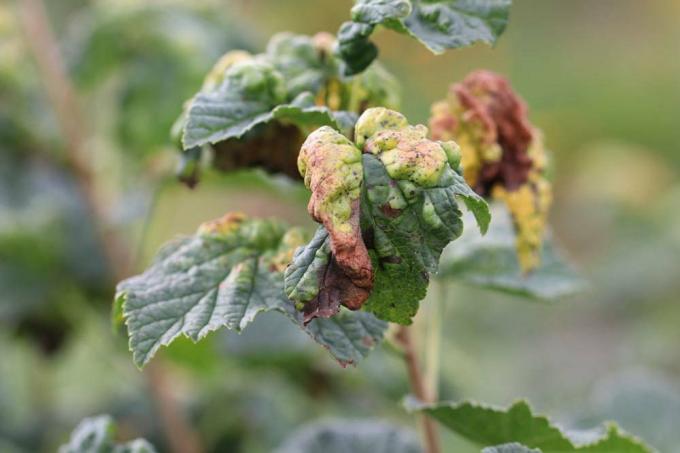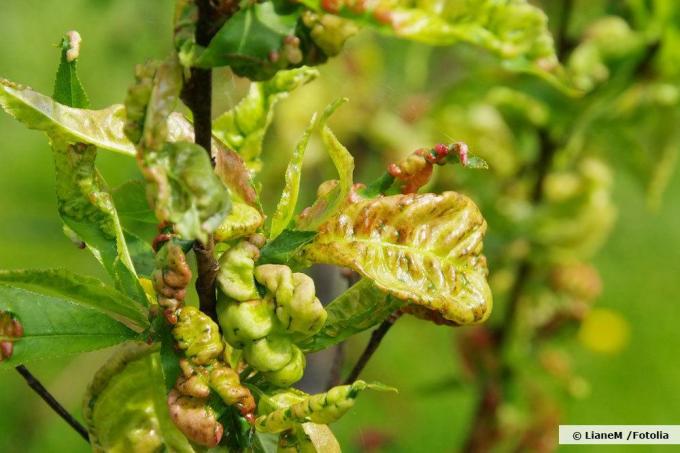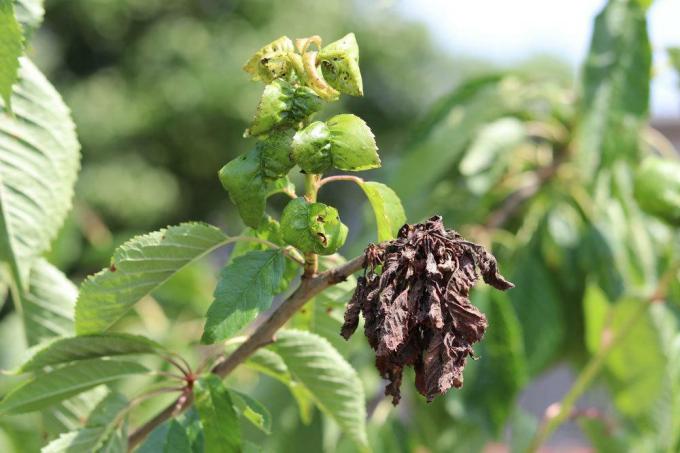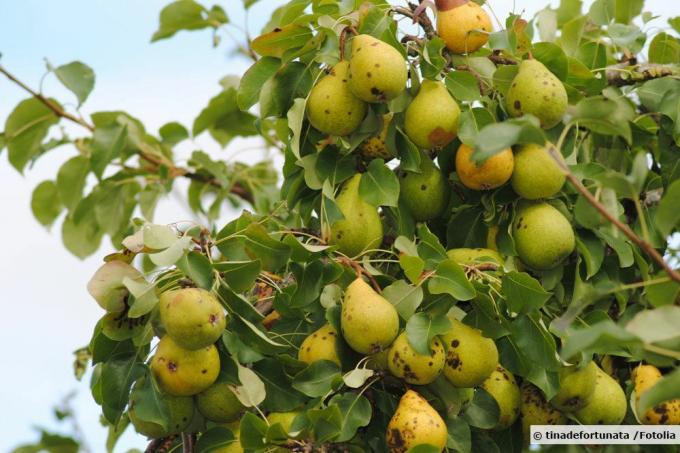
table of contents
- Fruit tree diseases from A - Z
- Apple scab
- Bacterial burn
- Pear grid
- Leaf fall disease
- Powdery mildew
- Fire blight
- Frizziness
- Toad skin disease
- Monilia fruit rot
- Monilia peak drought
- Fruit tree cancer
- Red pustular disease
Fruit trees should not be missing in any garden, because fruit simply tastes best fresh from a tree or bush. Unfortunately, no matter how well they are cared for, they can be attacked by various fruit tree diseases. They can be caused by viruses, bacteria and fungi, but can also be transmitted by pests. Therefore you should keep an eye on the trees all year round. If detected early, fruit tree diseases can often be treated well, in the best case of course without chemical agents.
Fruit tree diseases from A - Z
Determine and fight
It is not easy to clearly determine fruit tree diseases due to the large number and sometimes parallel occurrences. While some occur on different fruit trees, others only attack certain types of fruit. Some diseases, such as fire blight, must be reported. Fruit tree diseases first show up in changes in the leaves, flowers and fruits, but branches, trunks and roots can also be affected later. In order to be able to determine damage patterns, it is necessary to compare, analyze and control.
Apple scab
Apple scab is one of the diseases that can affect apples and pears. If there is an infestation, olive-green to brown, irregularly shaped spots appear on and under the leaves and on the fruits from May onwards. Brown, cracked spots develop from the spots on the fruits, where fruit rot fungi can settle. Taste and shelf life suffer.
- Treat apple trees with preparations containing copper
- Remove infected leaves
- In the event of severe infestation, use approved fungicides as an emergency solution
- As a preventive measure, remove the autumn leaves lying on the ground
- Fruit trees early with plant strengthening Horsetail broth treat
Bacterial burn
Bacterial blight mainly affects pome fruit such as plum, pear and cherry trees. It occurs preferentially in spring when the buds shoot and in autumn when the leaves are falling, in damp and cool weather. Recognized too late, this disease can become a serious problem for the tree.
Infested fruit trees show round, 1-2 mm small leaf spots in early summer. They are initially light, later turn brown and dry up. They have a light green, slightly chlorotic edge. In some cases, flowers, buds and fruits can also be affected and rubber flow can occur. The bark of the trunk and branches shows dark, sunken areas.
- Cut out infected branches and trunk sections into healthy wood
- Treat cuts with wound closure agent
- Any clippings in the household garbage, do not dispose of on the compost
- Curb disease with copper-containing fungicides
- Inject the agent before the first frost and during the leaf fall
- Spray fruit trees until they're dripping wet
- Complete recovery of the plant, usually not possible with these means
- First of all, fungicides have a preventive effect
Pear grid
Pear grating is one of the diseases that only affect pear trees. Again, a fungus is responsible. Infestation is favored by the proximity of a juniper tree, which the fungus uses to overwinter before moving back to the pear tree in early spring. The trees do not necessarily have to be directly next to each other, because winds can carry the fungal spores more than 500 m. Clear symptoms of an infestation are irregular, orange-red spots on the leaves from around May / June. The fungus leaves wart-like thickenings on the underside of the leaves, in which the spores mature.
- Spread can be stopped with early application
- Remove diseased parts of a nearby juniper
- If the infestation is severe, remove the juniper completely
- This alone does not eliminate the infestation on the fruit tree
- Spores can also fly in over greater distances
- Spraying for prevention and control with a suitable fungicide
- Inject as a preventive measure at the start of budding
Leaf fall disease
Josta berries, gooseberries and currant bushes can be affected by leaf fall disease. The responsible harmful fungus overwinters on the leaves lying on the ground. In the spring, the spores are then transferred to the freshly sprouted leaves by the wind and the shrub is infected. Plants lose a large part of their leaves prematurely.
Symptoms of an infestation are brownish to black leaf spots of various sizes, initially on the underside of the leaves. The spots get bigger and run into one another until the whole leaf is affected. They fall off and growth stagnates. Direct control is not possible. However, fallen leaves should be removed and otherwise the plant population should not be too dense so that the leaves can dry out quickly again and again.

tip: This fruit tree disease can be prevented by paying attention to optimal cultivation conditions and care in advance and by giving preference to varieties with a low susceptibility.
Powdery mildew
Powdery mildew is a fair weather fungus because it occurs when the weather is particularly nice, i.e. warm and dry, with temperatures of more than 20 ° C. The fungus appears from around July and overwinters on parts of plants that are still alive. All green parts of the plant are attacked. Symptoms of an infestation can be seen in apples, pears, table grapes and gooseberries.
When infected, the fungus covers the shoots, leaves and fruits with a whitish, washable coating. After several consecutive hot days and cool nights with heavy dew formation, the infestation is particularly strong. Affected plants grow more slowly. However, it is rare for the entire plant to die.
- Remove infected parts of the plant
- Regular sprayings with herbal broths
- Alternatively, fight powdery mildew with suitable fungicides
- Prevention is the best protection against powdery mildew
- Consequently, pay attention to well-ventilated locations
- Leaves should be able to dry off quickly
- Mushrooms need moisture to develop
- Morning dew can be enough
- Accordingly, thinning out fruit trees regularly
- Pay attention to a balanced supply of nutrients
- Prefer resistant varieties
Fire blight
Fire blight is triggered by a bacterium and affects fruit trees such as apples, pears, quince and other pome fruit. It can spread very quickly and is initially evident in dried-up looking flowers, fruits and young shoots. The affected parts later turn dark brown to black and look like they have been burned. With high humidity, a sticky bacterial slime can appear on the infected parts of the plant.
- Diseases such as fire blight are notifiable
- Report this to the responsible plant protection office immediately
- There is no effective means of combating it
- Remove all affected parts of the plant
- Cut at least 30 cm into healthy wood
- Remove all clippings
- Do not dispose of on the compost
- It is best to collect them in plastic bags and burn them later
- Thoroughly clean and disinfect any cutting tools used

tip: To counteract an outbreak of this disease, it is advisable to look for particularly resistant varieties when buying fruit trees.
Frizziness
Diseases such as curl disease can be determined comparatively easily. She is through one Hose fungus causes and occurs on peaches, cherries, nectarines and apricots. The fungus lives from June to February in dead, decomposing plant material, on shoots and bud scales, on which it feeds and in which it also hibernates.
The leaves of affected fruit trees are thickened and blistered. They turn yellowish to reddish in color, curl up, then dry up and fall off. There is a velvety covering on the top of the leaves. However, fruits are rarely attacked. If the infestation is severe, rubber flow can occur, so that entire shoots die.
- Fight frizziness as early as possible
- The risk of infection increases at temperatures above 10 ° C
- Collect and dispose of the leaves lying underneath
- Cut the affected shoots back into the healthy wood
- Fertilize the plant to strengthen it
- Fight fungus directly with a broad spectrum fungicide
- Plant strengtheners are very effective as a preventive measure
- Continue treatment consistently until bud

tip: In spring, the spores of Taphrina deformans get between the newly sprouted young leaves through wind or rain, which can only be infected now. To counteract this, you should therefore pay attention to a sunny and, above all, airy location when planting.
Toad skin disease
- Toad disease caused by wound parasites
- Penetrate trees through open sores
- The disease affects sweet cherries, peaches, apricots and plums
- Mainly occurs after frost damage
- Symptoms are elongated, dead parts on the branches
- Affected parts of the bark have bulging areas
- These stand out from healthy tissue
- The pustule-like fruiting bodies sit on the tumors

Combat is limited to prevention. It's all about the right location. Because the tree should be protected from frost and waterlogging. Heavily affected branches can be completely removed and areas affected by necrosis can be cut out into healthy tissue.
Monilia fruit rot
Monilia fruit rot affects pome and stone fruit such as apples, pears, plums and cherries, both ripe and unripe fruits and the fruit tree itself. This disease is spread by wasps during fruit ripening. At first, there are small rotten spots on the fruit. They turn brown inside and out and have circular, white-greyish spore beds. The affected fruits later fall down or dry up on the tree. One then speaks of fruit mummies.
Since the fungus hibernates in the fruits, it is important to completely collect and destroy any infected fruits that are still on the tree and those that have already fallen. If you leave the fruit mummies on the tree, they can infect healthy fruits for the next year.
Monilia peak drought
The Monilia peak drought can affect apple, pear, plum, apricot, peach, sweet and sour cherry trees. The causative fungus penetrates the shoots through the flowering in spring and damages them so severely that parts of the plant die off. The fruits that later hang on the tree as fruit mummies are also attacked. Since the fungus overwinters in the shoot tips, infected shoots must be cut back into the healthy wood immediately after flowering.

Fruit tree cancer
Fruit tree cancer is also triggered by fungi that penetrate the plant through interfaces and cracks. Apple and pear trees in regions with high rainfall are at risk. The first signs of infestation are small, brown-red spots. Cancerous tumors form on older branches or on the trunk and continue to expand. Above these growths, shoots and branches die off.
- Cut the affected trees back into healthy wood
- Treat larger cuts with wound sealant
- Dispose of clippings in residual waste or burn them
- Cut young shoots about a hand's breadth below the growths
- Supplementary spraying with fungicides containing copper
- Avoid injuries to the trees as much as possible as a preventative measure
- Avoid locations that are too wet and varieties with increased susceptibility

Red pustular disease
Host plants for red pustular disease include pome and stone fruit. The pathogen mainly attacks dead plant parts and penetrates healthy tissue through open wounds. If the water content in the wood then decreases, the fungus can spread quickly. Yellow to pale red spore beds can be seen on the bark. Infested wood should therefore be cut out after the vegetation period and a balanced supply of water and nutrients should be ensured.







